2000 AUDI ALLROAD engine
[x] Cancel search: enginePage 281 of 306
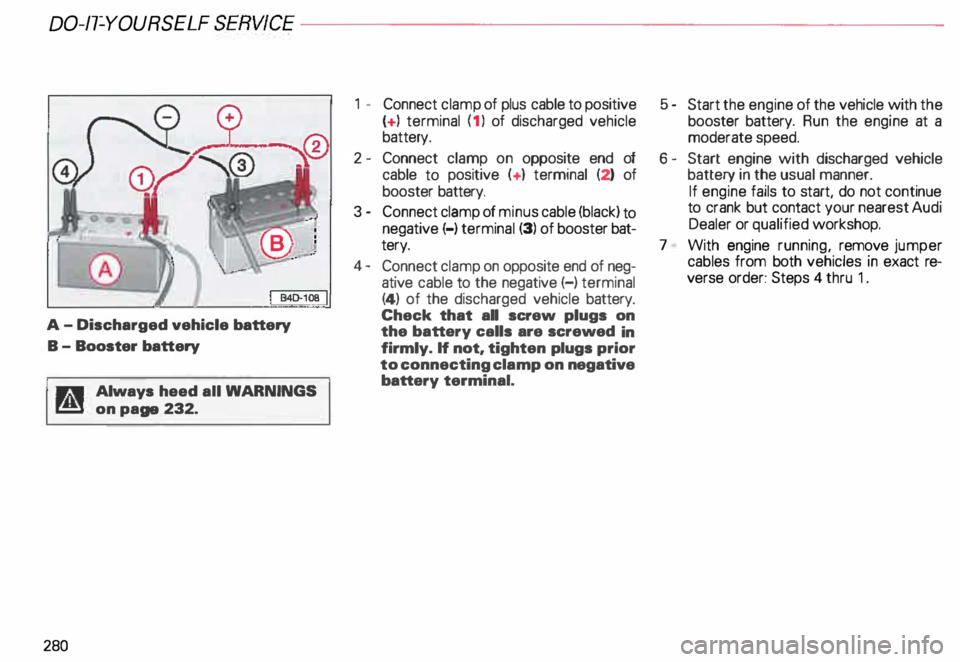
DO-IT-YOURSELF SERVICE----------------------
A-
Discharged vehicle battery
B - Booster battery
11r,:!1 Always heed all WAR NINGS
r!!l on page 232.
280 1
- Connect clamp of plus cable to positive
( + ) terminal (1 ) of discharged vehicle
battery.
2 - Connect clamp on opposite end of
cable to positive (+ ) terminal (2) of
booster battery.
3 - Connect clamp of minus cable (black) to
negative (-) terminal (3) of booster bat
tery.
4- Connect clamp on opposite end of neg
ative cable to the negative (-) terminal
(4) of the discharged vehicle battery.
Check that all screw plugs on
the battery calls are screwed in
firmly. If not, tighten plugs prior
to connecting clamp on negative
battery terminal. 5
- Start the engine of the vehicle with the
booster battery. Run the engine at a
moderate speed.
6- Start engine with discharged vehicle
battery in the usual manner.
If engine fails to start, do not continue
to crank but contact your nearest Audi
Dealer or qualified workshop.
7 With engine running, remove jumper
cables from both vehicles in exact re
verse order: Steps 4 thru 1.
Page 282 of 306
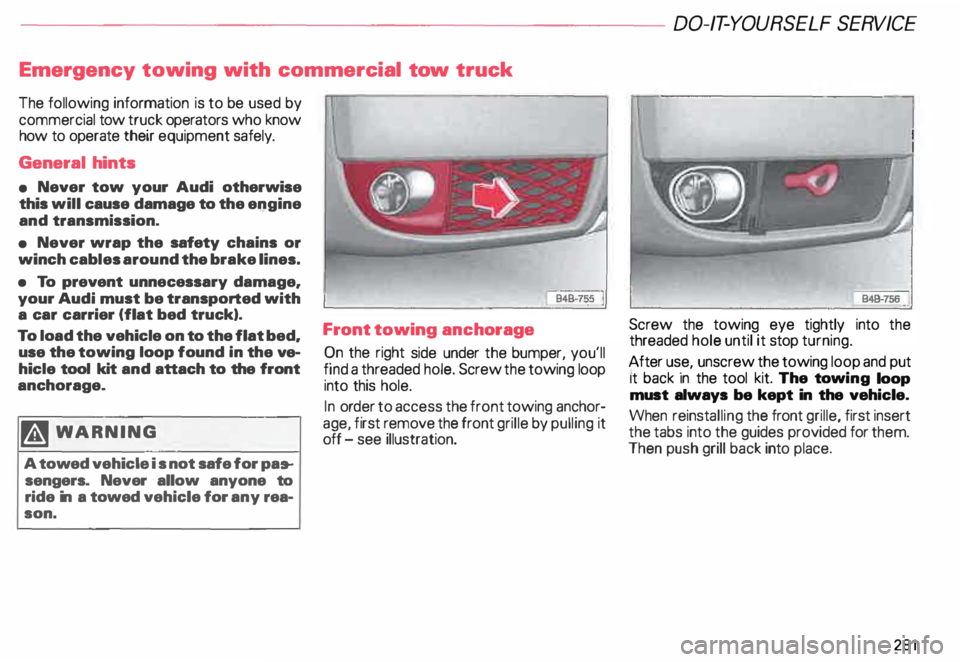
---------------------DO-IT-YOURSEL F SERVICE
Emergency towing with commercial tow truck
The following information is to be used by
commercial tow truck operators who know
how to operate their equipment safely.
General hints
• Never tow your Audi otherwise
this will cause damage to the engine
and transmission.
• Never wrap the safety chains or
winch cables around the brake lines.
• To prevent unnecessary damage.
your Audi must be transported with
a car carrier (flat bed truck).
To load the vehicle on to the flat bed.
use the towing loop found in the ve
hicle tool kit and attach to the front
anchorage.
�W ARNING
A towed vehicle is not safe for pas
sengers. Never allow anyone to
ride in a towed vehicle for any rea
son. Front towing
anchorage
C? n the right side under the bumper, you'll
fmd a threaded hole. Screw the towing loop
into this hole.
In ord .er to access the front towing anchor
age, f1rst remove the front grille by pulling it
off -see illustration. Screw the towing eye tightly
into the
threaded hole until it stop turning.
After us .e, unscrew the towing loop and put
1t back In the tool kit. The towing loop
must always be kept in the vehicle.
When reinstalling the front grille, first insert
the tabs into the guides provided for them.
Then push grill back into place.
281
Page 284 of 306
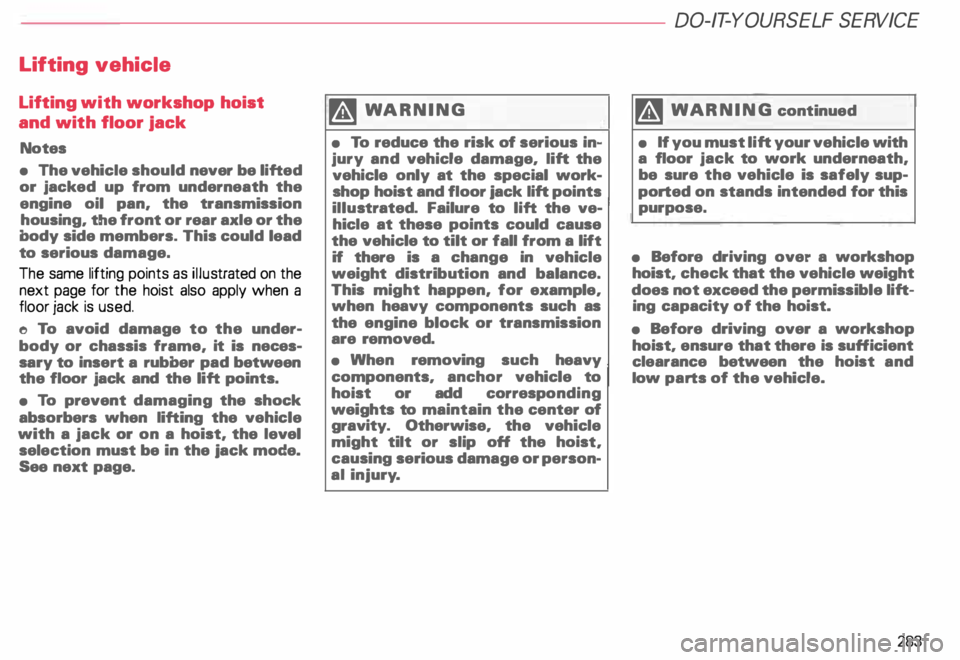
Lifting
vehicle
Lifting with workshop hoist
and with floor jack
Notes
• The vehicle should never be lifted
or jacked up from underneath the
engine oil pan, the transmission
housing, the front or rear axle or the
body side members. This could lead
to serious damage.
The same lifting points as illus trated on the
next page for the hoist also apply when a
floor jack is used.
e To avoid damage to the under
body or chassis frame, it is neces
sary to insert a rubber pad between
the floor jack and the lift points.
• To prevent damaging the shock
absorbers when lifting the vehicle
with a jack or on a hoist, the level
selection must be in the jack mode.
See next page. �W
ARNING
• To reduce the risk of serious in
jury and vehicle damage, lift the
vehicle only at the special work
shop hoist and floor jack lift points
illus trated. Failure to lift the ve
hicle at these points could cause
the vehicle to tilt or fall from a lift
if there is a change in vehicle
weight distribution and balance.
This might happen, for example,
when heavy components such as
the engine block or transmission
are removed.
• When removing such heavy
components, anchor vehicle to
hoist or add correspo nding
weights to maintain the center of
gravity. Otherwise, the vehicle
might tilt or slip oH the hoist,
causing serious damage or person
al injur y. DO-IT-YOU
RSELF SERVICE
�� WARNING continued
• If you must lift your vehicle with
a floor jack to work underneath,
be sure the vehicle is safely sup
ported on stands intended for this
purpose.
• Before driving over a workshop
hoist, check that the vehicle weight
does not exceed the permissible lift
ing capacity of the hoist.
• Before driving over a workshop
hoist, ensure that there is suHicient
clearance between the hoist and
low parts of the vehicle.
283
Page 287 of 306

TE
CHNICAL DAT
A-------------------------
Engine data
Maximum output SAE net
Maximum torque SAE net
No. of cylinders
Displacement
Stroke
Bore Compression ratio
Fuel1l
11 For further details see "Fuel supply" on
page 225.
286 250
hp at 5800 rpm
258 ft. lbs. at 1850 rpm
6
16 3 CID (2671 cm3)
3.40 in (86,4 mm)
3.19 in (81 .0 mm)
9.3 : 1
Premium unleaded
Page 288 of 306
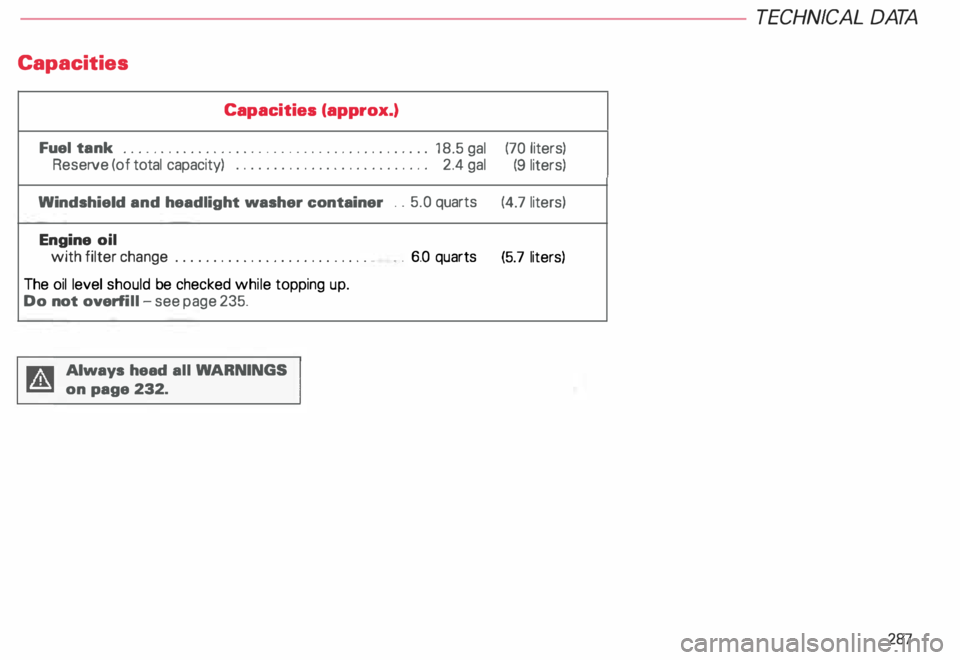
Capacities
Capacities (approx.)
Fuel tank
••••••• •••••••••• ••••••••••••••••• 0 ••• 0 ••
18.5 gal
Reserve (of total capacity) ............
..............
2.4 gal
Windshield and headlight washer container ..
5.0 quarts
Engine oil
with filter change .......................... •
The oil level should be checked while topping up.
Do not overf ill -see page 235.
Always head all WA RNINGS
on page 232. .
. 6.0 quarts TECHNICA
L DAT A
(70 liters)
(9 liters)
(4.7 liters)
(5.7 liters)
287
Page 292 of 306
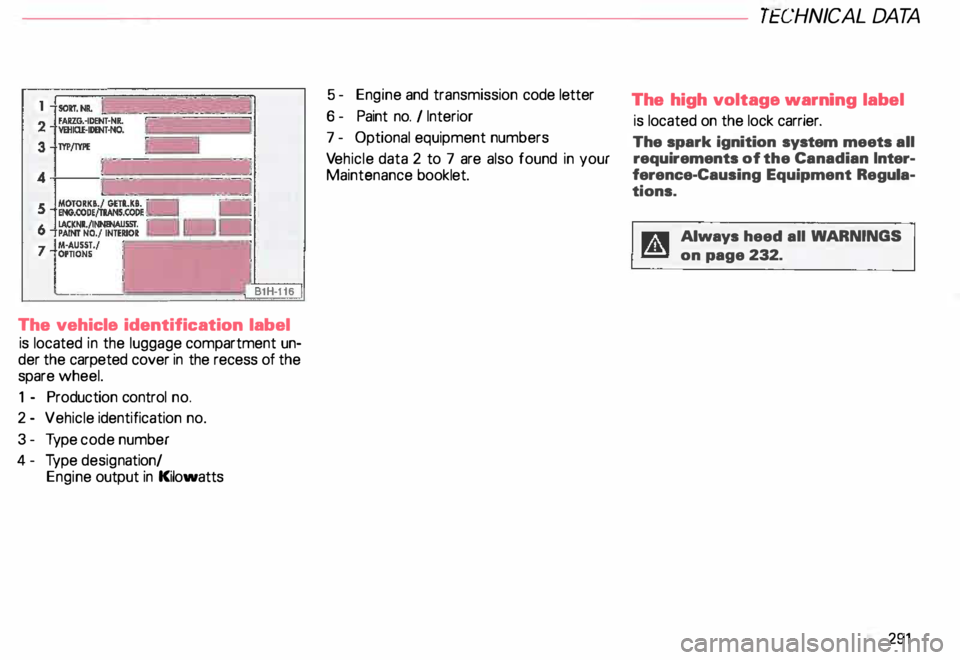
The
vehicle identification label
is located in the luggage compartment un
der the carpeted cover in the recess of the
spare wheel.
1 - Production control no.
2 - Vehicle identification no.
3- Type code number
4- Type desig nation/
Engine output in Kilowatts 5 -
Engine and transmission code letter
6- Paint no. I Interior
7 - Optional equipment numbers
Ve hicle data 2 to 7 are also found in your
Maintenance booklet. TECHNICA
L DA TA
The high voltage warning label
is located on the lock carrier.
The spark ignition system meets all
requirements of the Canadian Inter
ference- Causing Equipment Regula
tions. D Always heed all WARNlNGS
f!!l on page 232.
291
Page 293 of 306
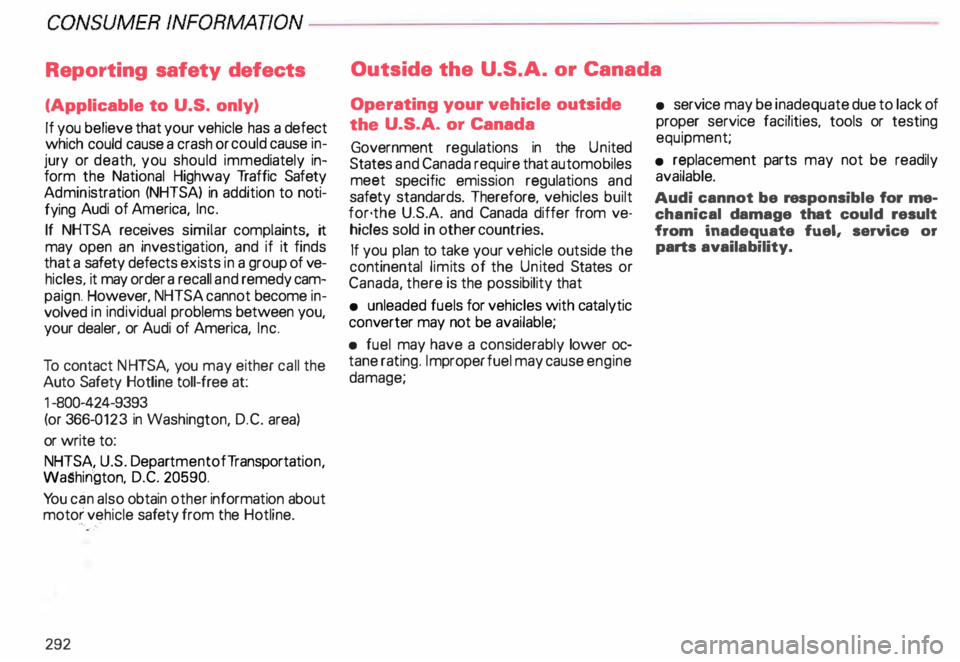
CONSUMER
INFORMAnON-------------------------------------------
Reporting safety defects
(Applicable to U.S. only)
If you believe that your vehicle has a defect
which could cause a crash or could cause in
jury or death, you should immediately in
form the National Highway Traffic Safety
Admin istration (NHTSA) in addition to noti
fying Audi of America, Inc.
If NHTSA receives similar complaints, it
may open an investigation, and if it finds
that a safety defects exists in a group of ve
hicles, it may order a recall and remedy cam
paign. However, NHTSA cannot become in
volved in individual problems between you,
your dealer, or Audi of America, Inc.
To contact NHTSA. you may either call the
Auto Safety Hotline toll-free at:
1- 800-424-9393
(or 366- 0123 in Washington, D.C. area)
or write to:
NHTSA, U.S. Depar tmentofT ransportat ion,
washin gton, D.C. 20590.
Yo u can also obtain other information about
motor vehicle safety from the Hotline.
292 Outside the
U.S.A. or Canada
Operating your vehicle outside
the U.S.A. or Canada
Government regulations in the United
States and Canada require that automobiles
meet specific emission regulations and
safety standards. Therefore, vehicles built
for·the U.S.A. and Canada differ from ve
hicles sold in other countries.
If you plan to take your vehicle outside the
continental limits of the United States or
Canada, there is the possibility that
• unleaded fuels for vehicles with catalytic
converter may not be available;
• fuel may have a considerably lower oc
tane rating. Improper fuel may cause engine
damage; •
service may be inadequate due to lack of
proper service facilities, tools or testing
equipment;
• replacement parts may not be readily
available.
Audi cannot be responsible for me
chanical damage that could result
from inadequate fuel, service or
parts availability.
Page 297 of 306

ALP
HABEnCAL INDEX----------------------------------------------
A
Acoustic park assist
Adding - Brake fluid ...
- Engine coolant
. . . . . • • •
- Engine oil . . . . .
... •.• .. __ 11
2
242
240
236
Additional accessories ..
262
Adjusta ble steering column . . . . . 98
Adjusting
- Climate controls . . . . . . . . . . 163
- Head restraints . • . . . . . 75, 79
-M irrors . . . . . . . . . • • . . . . . . . 72
-S eats .... ... ............ ... 76
- Washer jets . . . . . . . . . . . . . . . 250
Air circulation -luggage compart-
ment ........ .. ... .... .. . 89
Air cleaner ...... .. ... . _ .... . .. 248
Air conditioning . . . . . . . , . .
162
Air outlets . . . . . 165
Air recirculation
... ••• , • • . .
164
Air suspension .
153
Air vents . . . . . . • . . . . . . 165
Airbag . . . . . . . . . . . . . . . .
25
- System components
25
?00 Airbag
system . • . . . . • • • . . . . 25
-C are....... .. .. .. .. 41
- Disposal . . . . . . . . . • • . • . . .
41
- Front airbags . . . . . . . . . . . .
25
- How it works (front airbag) . . . 27
-S eating position . .
29
-S ervice .. .. .. .. ... _ ... 41
Alarm system . .
• . . . . • • • • . . . . 67
All Wheel Drive
. . . . 207
Alternator . . . . . 120, 127
Ambient lighting . . . . . . . _ . . . . . 172
Anti-Lock Brake System ..•.... 202
Anti-theft alarm system . . . . ...
67
Armrest . . . . . . . . . . . . . . . . . 85, 263
Armrest with telephone ..... _ . . 19 0
Ashtray . . . . . . . . . . . . . .
180
Auto-Check System . . .
1 38
Automatic air recirculation . . . . . . 164
Automatic headlight adjustment . 14 8
Automatic shift lock . . . . . . . . .
106
Automatic transmission . . . . . . 1 04
- Back-up lights . . . . . . . . . . .
1 08
- Ign ition key safety interlock 1
04
- Reverse 1
08
- Tiptronic
105 B
Back-up lights- Automatic
transmission .
1 08
Battery . . . . . . .
. . . . . • • • 244
-C harging . .
. . • . . • .... . 246
- Replacing . . . . . 248
- Winter operation .
. . . . . . . . . 245
Belt tensioner . . . . . . • • • . • . .
. 24
Body cavity sealing .
220
Bolt-on hubcap . . . . . . . . . • . . 269
Booster seats ....... .. .. ... .. _ . 48
Boo t.............. .
184
Brake booster. . . . . . . . . . . . . . . . . 201
Brake fluid . . . . . . . . . . . . . • • . . • . . 242
Brake fluid reservoir . . . 242
Braking . . . . . . . . . . . 201
Break-in period . . • . . . . . 193
Bulb replacing . • . . . • • • • . . • 277
Buzzer 113